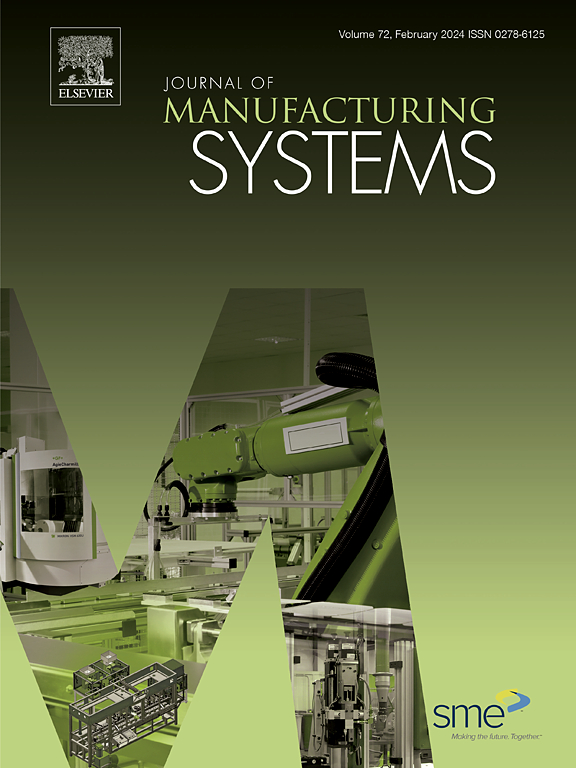Data-physics collaborativige fusion prediction method for tool remaining useful life based on Mamba state space and physical description
IF 12.2
1区 工程技术
Q1 ENGINEERING, INDUSTRIAL
引用次数: 0
Abstract
Tool wear is an inherent phenomenon of the metal cutting process, the traditional replacement strategy relies on experience or a fixed cycle easily leads to waste of resources or workpiece damage, accurate prediction of the tool's remaining useful life (RUL) has become a key issue in the field of intelligent manufacturing urgently need to break through. Aiming at the problems of insufficient nonlinear processing capability of physical models and weak interpretability of data-driven models in the existing RUL prediction, this study proposes a data-physics collaborative fusion prediction method for tool remaining useful life based on Mamba state space and physical description. The method breaks through the traditional single-model paradigm and achieves in-depth characterization of the cutting process through a dual modeling mechanism: firstly, a time-series feature extraction network based on the Mamba state space is constructed, and a selective memory mechanism is adopted to achieve the screening of degradation features and non-linear characterization; secondly, a two-stage piecewise physical degradation model is established. The explicit mathematical expressions are deduced based on the geometrical features of the tool wear curve, and the prior distributions of the model parameters are estimated from historical data. The Particle Filter (PF) algorithm is introduced to establish a collaborative optimization mechanism for the dual models, and the physical parameters are dynamically updated through importance sampling to achieve tool RUL prediction under Data-physics collaborative fusion (DPCF). The experimental results show that the method can achieve accurate monitoring of tool RUL and has a certain reference value for efficient tool change in the metal-cutting process.
基于曼巴状态空间和物理描述的工具剩余使用寿命数据-物理协同融合预测方法
刀具磨损是金属切削过程的固有现象,传统的依靠经验或固定周期的更换策略容易导致资源浪费或工件损坏,准确预测刀具的剩余使用寿命(RUL)已成为智能制造领域急需突破的关键问题。针对现有RUL预测中物理模型非线性处理能力不足、数据驱动模型可解释性弱的问题,提出了一种基于曼巴状态空间和物理描述的工具剩余使用寿命数据-物理协同融合预测方法。该方法突破了传统的单模型范式,通过双重建模机制实现对切削过程的深度表征:首先构建基于曼巴状态空间的时间序列特征提取网络,采用选择性记忆机制实现退化特征的筛选和非线性表征;其次,建立了两阶段分段物理降解模型。根据刀具磨损曲线的几何特征推导出显式数学表达式,并根据历史数据估计出模型参数的先验分布。引入粒子滤波(PF)算法,建立双模型协同优化机制,通过重要采样动态更新物理参数,实现数据-物理协同融合(DPCF)下的工具RUL预测。实验结果表明,该方法能够实现对刀具RUL的精确监测,对金属切削过程中高效换刀具有一定的参考价值。
本文章由计算机程序翻译,如有差异,请以英文原文为准。
求助全文
约1分钟内获得全文
求助全文
来源期刊

Journal of Manufacturing Systems
工程技术-工程:工业
CiteScore
23.30
自引率
13.20%
发文量
216
审稿时长
25 days
期刊介绍:
The Journal of Manufacturing Systems is dedicated to showcasing cutting-edge fundamental and applied research in manufacturing at the systems level. Encompassing products, equipment, people, information, control, and support functions, manufacturing systems play a pivotal role in the economical and competitive development, production, delivery, and total lifecycle of products, meeting market and societal needs.
With a commitment to publishing archival scholarly literature, the journal strives to advance the state of the art in manufacturing systems and foster innovation in crafting efficient, robust, and sustainable manufacturing systems. The focus extends from equipment-level considerations to the broader scope of the extended enterprise. The Journal welcomes research addressing challenges across various scales, including nano, micro, and macro-scale manufacturing, and spanning diverse sectors such as aerospace, automotive, energy, and medical device manufacturing.
 求助内容:
求助内容: 应助结果提醒方式:
应助结果提醒方式:


